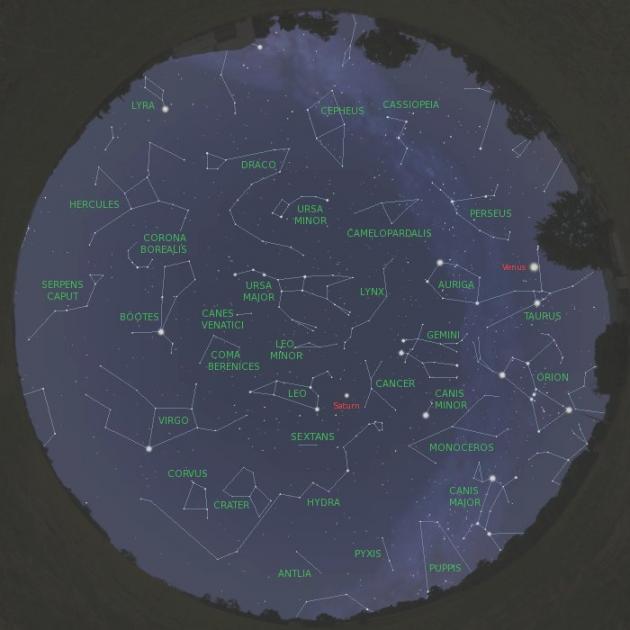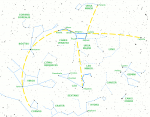- News / Thoughts
- Astronomy Guide
- On This Day
- Reviews
- Bookstore
Astronomical Events for April 2007
04/01/2007As the weather becomes warmer, winter hexagon slips below western horizon sooner and sooner. What we can see now are spring constellations. This month, you'll learn, or repeat you knowledge of, several of them: Cancer, Leo, Böotes, Corona Borealis, Virgo and Corvus.
Venus and faithful Saturn are still our only evening planets, but we're almost used to them since we're already watch them for a few months now...
And for simple pleasure, at the end of month, we can watch meteor shower called Lirids!
O

Evening sky for the middle of April 2007. at 9:30 PM. The map is valid for northern hemisphere, especially positions near 45 degrees latitude.
Compared to previous month, this one is quite void of spectacular events, hence I'll try to show you how to find spring constellations.
Winter hexagon (described in January) is, well... winter-ish :), and as warmer weather keeps arriving it'll set below horizon sooner then before. Thus, we wont be able to use the, now recognizable pattern of, Orion as our celestial guidepost. Luckily the Big Dipper is easily recognizable asterism (a star pattern which is not constellation), and most people learn to recognize it in child age.
If you don't know to find Big Dipper by now, you can ask your friend, parents or even grandparents... they'll probably be glad to show it to you. Failing that, for whatever reason, this month you can just look up around 21:30, Big Dipper will be right above you (compare your view to to map at the top of the page). Big Dipper asterism is quite big, and you might be a bit confused by it's size, so stretch your arm above you, and spread your fingers. The Big Dipper is a bit larger then the maximum distance of your thumb and little finger.
To better understand following text, I'd recommend that you open the largest version of the image on the right...
o
O

Spring constellations and how to find them
Big Dipper is in fact only part of the constellation Ursa Major (The Big Bear). Ursa Major is quite bigger on celestial sphere. In fact, to be blunt or perhaps a bit funny, Big Dipper is only the tail and the butt of the Ursa Major :)
Main reason behind why so many people recognize Big Dipper is that we can use it to find North Star (Polaris). By using its stars Merak and Dubhe, and stretching that line around five times, you'll arrive to the North Star, and thus find the true north. You can imagine how important this was to ancient seafarers, or even today for professions or hobbies where orienting oneself is important.
Constellation of Ursa Minor (Little Bear) is easily recognizable once you've located Polaris. It's almost a replica of the Big Dipper, with it's "handle" bent to the other side. Ursa Minor is also known as asterism Little Dipper, and if we use those names, you can almost imagine how you pour something out of Little Dipper in Big Dipper. Can you imagine it?
You can see both, Big and Little Dipper throughout the year, but this month we'll use Big Dipper to find spring constellations. Once you learn this, it'll be your second signpost on evening sky.
Let's now use another two stars of Big Dipper, Megrez and Phad, and continue in other direction. While gliding "down" you'll not see many bright stars, but the first brighter one will be Regulus. It forms the front paws of the Lion. The shape of Lion constellation, actually looks like one!
Be careful... this year you can easily substitute planet Saturn with Regulus. It is located between constellations Leo and Cancer (you can use map at the top of the page to locate Saturn).
When you've found Regulus, try to recognize The Sickle, another well known asterism. The Sickle actually represents the mane and the head of a Lion. Now that you know the size of The Sickle, you'll easily recognize the hind legs, and thus whole constellation of Lion.
o
O

Open Cluster in Cancer called Beehive cluster or Praesepe. It is also object 44 in Messier catalog (M44). I'm seeing the flag at the top of the hill, representing a golf hole (feel free to giggle...)
The constellation of Cancer is a bit hard to find from urban areas, since light pollution gets in the way to see it's faint star pattern. To get around this draw imaginary line from Regulus in Leo to Pollux in Gemini (How to recognize Gemini is described in January events). The middle of that line marks the center of constellation of Cancer. If you take your binoculars and point in that direction you'll see a open cluster of stars. Lots of amateur astronomers call it Beehive cluster, but I see a flag on a hill, possibly marking a hole on a golf course :)
To find other spring constellations we have to use the handle of the Big Dipper. The handle is slightly bent, so if we follow it's arc away from Big Dipper, we'll stumble upon bright orange star called Arcturus. For observers of northern hemisphere, Arcturus is the second star in brightness, following the Sirius in Canis Major.
The Arcturus marks the base of Böotes constellation (usually translated as Herdsman). The constellation figure looks like a rhomboid paper dragon. Name Arcturus originates from Greek - Αρκτούρος, which means "bear guard". In fact, looking at those constellation group, it's easy to imagine how Böotes is "herding" Little and Big Bear across the sky, with a little help of Hunting Dogs (Canes Venatici constellation).
When you recognize the size and shape of Böotes, try to spot a small constellation of Corona Borealis (Northern Crown) on it's side. As a crown, it's shaped as half circle, and you may find that it's stars represent the jewels on the crown.
Let's continue down the arc Big Dipper - Böotes, and the next bright star, this time bluish-white colored, is Spica. Spica is the main star of the constellation Virgo (The Maiden). Once you spot it, it's easy to recognize the trapezoid shape of Maidens torso.
Looking towards the Leo constellation, you can recognize an arc of stars which may represent the opening arms of The Maiden. At that position, between the Maidens hand and the hind of Leo, there are a lot of galaxies. In fact since it's located inside Virgo constellation, it's commonly known as Virgo cluster of galaxies. Even with small, beginner, telescopes, you can spot many of them in various shapes and sizes, provided it's not near full Moon, and that you're far enough from urban areas and light polluted areas.
Leaving Virgo, lets continue down the arc Big Dipper - Böotes - Virgo once more. The last constellation location of this month is small trapezoid. The constellation is Corvus (The Crow).
If you're still reading this, and I haven't bored you to death, you may scroll at the top of the page, and find all mentioned constellations on evening sky map.
On the planet front, we're still having only two evening planets. Venus and Saturn are with us for quite some time now, and beside their position (which you may see at evening sky map), I won't describe them any more this month.
Near the end of month, we can enjoy in simple pleasure: watching Lirids meteor shower.
As our planet circles around the Sun, it gets hit by large amount of tiny dust particles. Great majority of those particles are smaller then a grain of sand, but, if we take into account the speed of Earth (30 km/s), when they hit our upper atmosphere, they ignite the gas around them and we see a streak of light. As they pass through our atmosphere we call those particles meteors, but many people (wrongly) call them falling stars.
Every night you can see sporadic meteors. When there is no full Moon, and in place with low light pollution you may see around 5-8 meteors per hour.
The concentration of those dust particles in Earths orbit is not the same, so every once in a while we pass through denser portions then usual.
This denser places of dust particles in interplanetary space is explained by comets. As the comet nears our Sun, it is heated, and begins to evaporate and disintegrate. Small particles are falling off of it, and under Suns light we see it as comets tail.
When we then pass through denser part of interplanetary dust, we can observe increasing number of falling stars. Therefore we call those occasions meteor showers.
While watching a meteor shower, observers can see that all meteors are streaking from the same point on the celestial sphere. The location of that origin of meteors gives a particular meteor shower a name. Although meteor showers are called by constellation meteors originates from, we should look outside that constellation. Stretch your arm toward the constellation. Make an imaginary circle around it using your thumb and little finger of spread hand. So watch streaks at the circumference of that circle, that is in the neighboring constellations!
Meteors of this months meteor shower originate in the constellation of Lyra (look at the sky map at the top), and are hence called Lyrids. In this case a single meteor is called Lyrid. Lyrid meteor shower increases falling star rate from usual 5-8 to 15 of them.
This months Lyrids peak, when we pass through the densest part of it, falls on Sunday 22nd at 22:00 UT. The Moon is in its first quarter, and shouldn't be too bright by then, since it's setting. All you have to do is get away from urban areas and light pollution, and enjoy the lovely streaks of light we call Lyrids.
Since we mentioned the Moon, let's end this months events with moon phases:
- Full Moon - April 2. 17:15 UT
- Last Quarter - April 10. 18:04 UT
- New Moon - April 17. 11:36 UT
- First Quarter - April 24. 06:36 UT